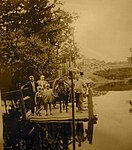Raft
A raft is any flat structure for support or transportation over water.[1] It is usually of basic design, characterized by the absence of a hull. Rafts are usually kept afloat by using any combination of buoyant materials such as wood, sealed barrels, or inflated air chambers (such as pontoons), and are typically not propelled by an engine. Rafts are an ancient mode of transport; naturally-occurring rafts such as entwined vegetation and pieces of wood have been used to traverse water since the dawn of humanity.
Human-made rafts

Traditional or primitive rafts were constructed of wood, bamboo or reeds; early buoyed or float rafts use inflated animal skins or sealed clay pots which are lashed together.[2]: 15, 17, 43 Modern float rafts may also use pontoons, drums, or extruded polystyrene blocks.[citation needed] Inflatable rafts up to the 20th century used flotation chambers made of goat- or buffalo-skins, but since then have mostly used durable, multi-layered rubberized fabrics. Depending on its use and size, it may have a superstructure, masts, or rudders.
Timber rafting is used by the logging industry for the transportation of logs, by tying them together into rafts and drifting or pulling them down a river.[citation needed] This method was very common up until the middle of the 20th century but is now[when?] used only rarely.
Large rafts made of
The type of raft used for recreational rafting is almost exclusively an inflatable raft, manufactured of flexible materials for use on whitewater.
Natural rafts
In
Rafting events are important means of
Image gallery
-
Three Arks for a log drive on Pine Creek, in Lycoming or Tioga County, Pennsylvania. The left ark was for cooking and dining, the middle ark was the sleeping quarters and the right ark was for the horses. The arks were built for just one log drive and then sold for their lumber. The line of the Jersey Shore, Pine Creek and Buffalo Railway can be seen on the eastern shore: the mountainside behind it is nearly bare of trees from clearcutting.[4]
-
Raft carrying visitors to Tom Sawyer Island at Disneyland, about 1960
-
People on the raft in Estonia, 1944
-
Raft used to bridge vehicles at Citarum River, Karawang, West Java, Indonesia
-
Rafting on theDunajec River at Pieniny, about 2005–2010
-
A woman using a raft to transport her daughter and goats
See also
- Floating island
- Great Raft
- Kon-Tiki
- L’Égaré II
- Las Balsas
- Lifeboat
- Pre-Columbian rafts
- Pumice raft
- The Raft of the Medusa
- Thor Heyerdahl
- Poon Lim
References
- ISBN 0-87779-339-5
- ISBN 9781473825598.
- ^ Smith, Cameron M. and Haslett, John F. (1999), "Construction and Sailing Characteristics of a Pre-Columbian Raft Replica", Bulletin of Primitive Technology, pp. 13–18
- ^ Thomas T. Taber, III "Williamsport Lumber Capital", 1995, page 13

![Three Arks for a log drive on Pine Creek, in Lycoming or Tioga County, Pennsylvania. The left ark was for cooking and dining, the middle ark was the sleeping quarters and the right ark was for the horses. The arks were built for just one log drive and then sold for their lumber. The line of the Jersey Shore, Pine Creek and Buffalo Railway can be seen on the eastern shore: the mountainside behind it is nearly bare of trees from clearcutting.[4]](http://upload.wikimedia.org/wikipedia/commons/thumb/a/a6/Pine_Creek_Arks.jpg/200px-Pine_Creek_Arks.jpg)




